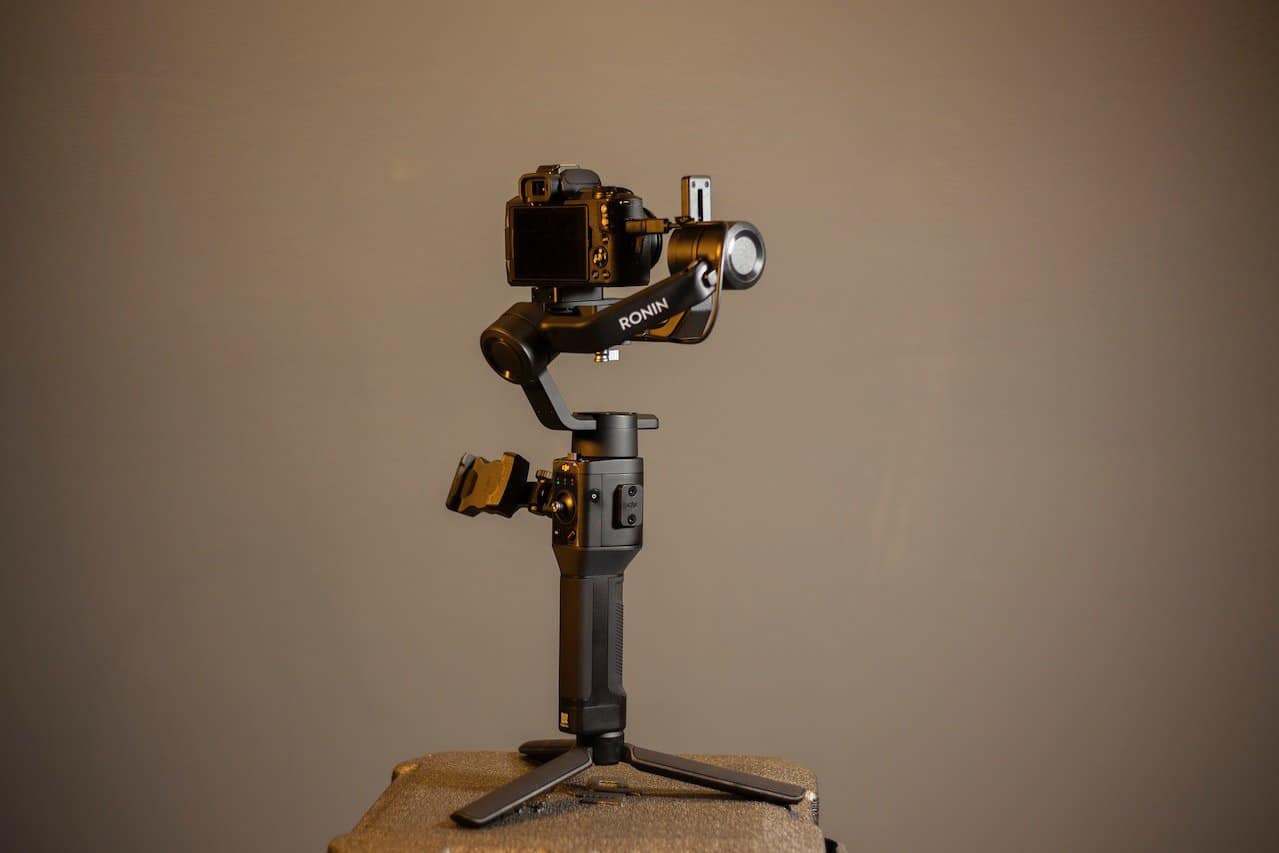
As an Amazon Associate we earn from qualifying purchases.
Although the Sony A7III is a high-quality camera with an advanced focusing mechanism and subject-tracking features, the quality of the gimbal you use can affect the sharpness of the photos and videos. I'm listing options for the best gimbal for Sony A7III to shoot real estate videos smoothly.
Quick Navigation
The DJI RS 3 Pro tops my list for the best gimbal for Sony A7III because of its high payload, three-axis system, and precise focusing detention to capture stable footage.
The best gimbals for Sony A7III allow you to adjust DSLR and mirrorless camera settings such as video start and stop. The following gimbals have three axes, offering smooth pans, tilts, and rolls that you can use in various shooting modes.
|
Best Overall
Brand:
DJI RS 3 Pro
|
Best for Tracking
Brand:
DJI RS 2 Combo
|
Best Battery Life
Brand:
Zhiyun Weebill S Gimbal
|
|
Max Payload:
10 lbs
|
Max Payload:
10 lbs
|
Max Payload:
6.6 lbs
|
|
Battery Life:
12 hrs
|
Battery Life:
12 hrs
|
Battery Life:
14 hrs
|
|
4.7
|
4.5
|
4.4
|
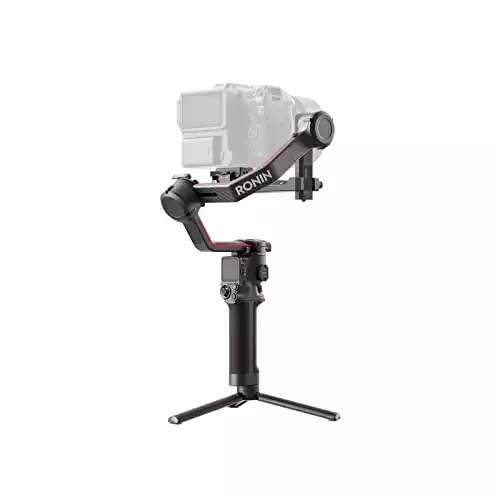
The DJI RS 3 Pro is one of the best gimbals you can use on the go, thanks to the automated axis locks. Typically, you only need to press and hold the gimbal power button when it’s powered off, and it will turn on, unlock the three axes, and expand automatically.
Like the DJI Ronin SC, the quick release plate with this gimbal allows you to mount your Sony A7III camera and start shooting conveniently using various shooting modes, including the panorama mode.
When you are done or want to change locations, simply press the power button once, and the axes will enter into sleep mode. Thus, this is the right gimbal for Sony A7III if you want to enhance storage and save a longer battery life.
Keeping in mind that the Sony A7III is an interchangeable lens camera, you might need to change the lenses to suit the scene you are capturing using a DSLR or mirrorless camera. Despite that, its ergonomic design comes with intuitive controls to eliminate shaky footage.
Like the DJI Combo, the tilt axis of this high-end gimbal comes with a fine-tuning knob that allows you to precisely slide the camera backward or forward to balance after changing the lens. However, the gimbal weighs 5.83 pounds and the maximum payload capacity might exhaust you if holding it for more extended periods.
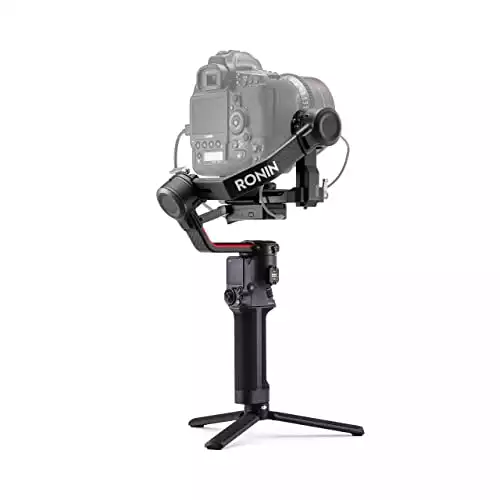
If you are looking for the perfect gimbal that offers the best weight-to-payload ratio, the DJI RS 2 Combo is an excellent gimbal for Sony A7III for heavier camera setups. Typically, this gimbal weighs 2.87 pounds, which is 2.96 pounds lighter than the DJI RS 3 Pro, yet it offers an equivalent maximum payload capacity of 10 pounds.
With 10.2 x 10.4 x 2.8 inches, this is the top gimbal for Sony A7III if you need a compact size, making it great for shooting handheld to ensure motion control and stable footage. Unlike aluminum, the sturdy carbon fiber construction ensures you don't have to worry about the gimbal breaking and your A7III camera falling.
Unlike the Zhiyun Weebill S, the gimbal comes with a 1.4-inch LCD screen that allows you to adjust the camera settings conveniently. There's also a quick release system for quick mounting and dismounting. This gimbal has a longer battery life of around 12 hours, which allows it to capture real estate photos the entire day without recharging.
The batteries support fast charging, and you can recharge them in 1.5 hours when using a 24 watts charger. Although this gimbal comes with ActiveTrack 3.0 technology, the tracking distance is limited, making it unsuitable when shooting distant subjects.
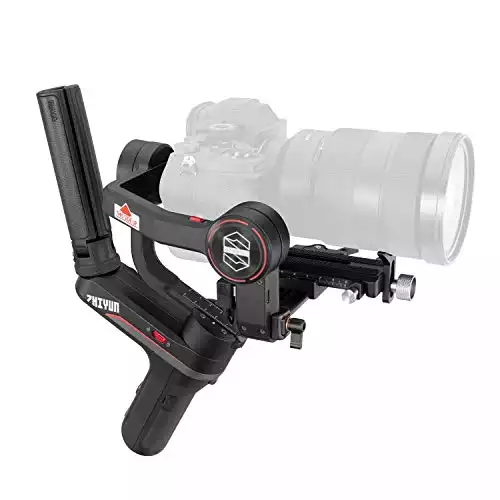
The Zhiyun Weebill S gimbal is one of the most versatile gimbals, featuring six operation modes. The main modes include Vortex Mode, which allows you to get 360 degrees barrel shots, and Full-Range POV Mode, which enables 360-degree synchronous camera movements of the three axes.
If you are capturing hyper-lapse videos using the A7III, you can use the PF mode that pans the camera as you turn the gimbal. On the other hand, if you are recording fast-moving subjects such as birds in a backyard, you can use the Go Mode. This makes it a reliable gimbal for Sony A7III that operates at maximum follow speeds while avoiding shaky footage.
This perfect gimbal has a battery life of 14 hours, allowing you to shoot for longer on a single charge compared to DJI RS 2 Combo's 12 hours. Whether you're using a DSRL or mirrorless camera, the gimbal supports the Zhiyun-Tech ZY Play app's intuitive control panel, letting you experiment with different shooting modes while ensuring motion control.
This app allows you to adjust your smartphone's various gimbal settings and functions. However, this app is not stable and requires frequent updates. Also, unlike the DJI RS 2 Combo, the 0.66-inch LCD screen is small, and you might strain your eyes when viewing.
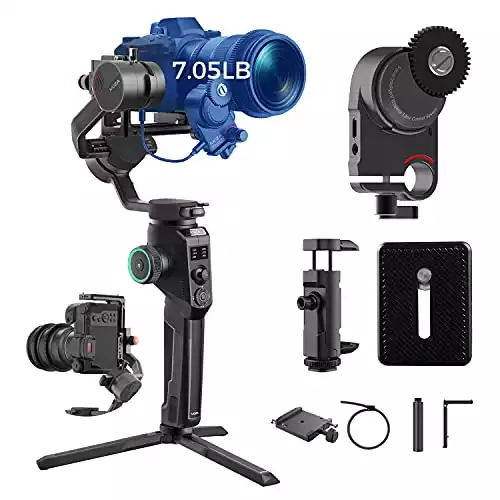
If you are shooting real estate exterior photos and you want a gimbal that can help you to capture the walls at the right angles without distortions, then the Moza Aircorss 2 might be the best choice for your Sony A7III.
This affordable gimbal comes with an artificial intelligence function with an intuitive control panel, helping the gimbal make calculations. The smart control panel adjusts the gimbal automatically depending on the camera's weight and attached lens.
After balancing the gimbal, the balance check feature helps to check and confirm whether the gimbal is indeed balanced and displays the results and necessary adjustments on the OLED screen.
This easy-to-use gimbal features an angled motor arm, allowing you to view the screen during operation conveniently. This enhances precision, allowing you to capture photos with minimal horizontal and vertical misalignments.
Like the Zhiyun Weebill S, this gimbal comes with a mobile app that allows precise control over the gimbal functions from your smartphone, saving battery life. A three-latch locking system lets you lock the axes to prevent movements, making it the top gimbal for Sony A7III that ensures smooth and steady footage.
This gimbal supports an impressive payload capacity of 7 pounds. However, this is 3 pounds lower than that of the DJI RS 3 Pro.
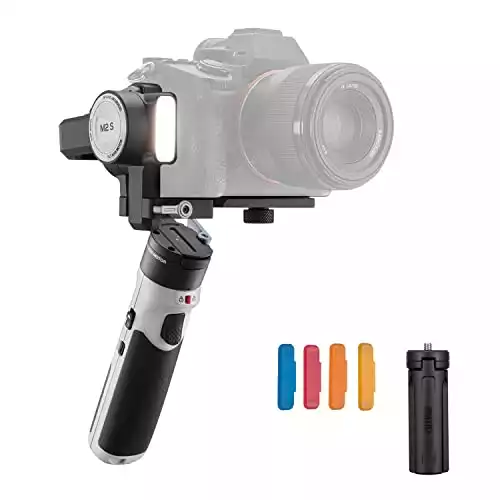
The Sony A7III camera has a lightweight design. If you want the best gimbals for Sony, consider going for the Zhiyun Crane M2. Typically, this lightweight gimbal weighs 1.08 pounds, making it the best gimbal for Sony A7III with a lightweight setup.
This compact and lightweight design allow you to hold the A7III and maneuver it freely in different shooting scenarios for an extended time without exhaustion. However, this design has a downside, as the gimbal has a maximum payload of 1.58 pounds.
Keeping in mind that the Sony A7III weighs 1.43 pounds, you can only mount lightweight lenses such as the 35mm and 28mm wide-angle lenses.
Like the Zhiyun Weebill S, the gimbal is compatible with the Zhiyun-Tech ZY Play app, which allows you to remotely control its settings and functions, such as slow-motion capture, panorama, and time-lapses, using a smartphone.
This easy-to-use gimbal supports WiFi and Bluetooth wireless connectivity. Since the Sony A7III comes with Bluetooth and WiFi connectivity, you can pair them and conveniently control functions such as video start and stop while saving battery life.
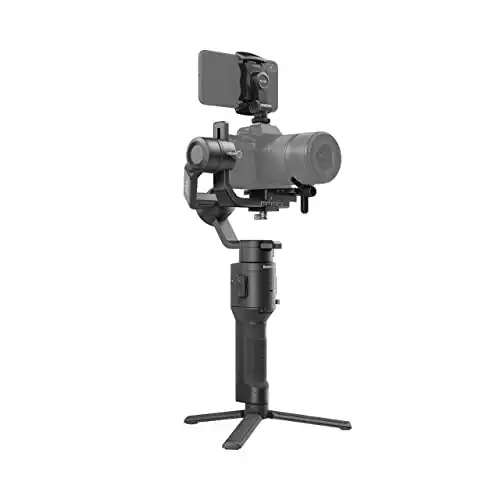
The DJI Ronin SC is one of the best gimbals for Sony A7III to create 360 degrees motion shots of real estate interiors. Typically, this gimbal comes with a 360-degree continuous panning feature and roll axis to can help you shoot 3D interior motion shots.
Unlike the Moza Aircorss 2, this gimbal comes with two locking modes that help you balance the A7III for shooting and storage, thanks to the sliding quick release plate.
Simply balance the A7III and put it in the lock position, unmount it with the plate, carry the easy-to-use gimbal in the storage mode, remount the camera and then unlock it.
This is a great gimbal for Sony A7III that comes with a re-center trigger button that helps to return the gimbal to the default position, allowing you to quickly re-center the gimbal and start tracking afresh. When tracking fast-moving subjects, press and hold the M button to enter the Sport Mode for smooth and steady footage.
This mode makes the DJI Ronin gimbal faster and more responsive in tracking when using mirrorless cameras. However, with a weight of 2.43 pounds and a payload of 4.4 pounds, this gimbal doesn't offer a good weight-to-payload ratio compared to the DJI RS 2 Combo.
A gimbal is a videography device that stabilizes DSLR cameras and mirrorless cameras. It lets you rotate a camera smoothly along an axis, making it easy to shoot sharp, clear videos.
The Sony A7III has impressive and advanced stabilization technology. However, it can be challenging to take creative shots only using a tripod, especially since a tripod requires a stable, fixed location.
A gimbal with advanced features lets you move and change positions while shooting using the A7III. Panning, tilting, and creating establishing shots can sometimes cause a camera to shake. The stabilizing feature of gimbals can control camera shakes to prevent blur.
The sharpness and steadiness of your real estate photos and videos generally depend on the quality of the camera gimbal you are using with mirrorless cameras. Usually, the best gimbals for Sony A7III come with varying performance modes and maximum payloads.
The following advanced features can help you choose a gimbal that suits the scene and the lens you pair with your Sony A7III. Also, the following table highlights the most crucial gimbal features to look out for.
| Gimbal | Payload (Pounds) | Battery Life (Hours) | LCD Screen? |
|---|---|---|---|
| DJI RS 3 Pro | 10 | 12 | Yes |
| DJI RS 2 Combo | 10 | 12 | Yes |
| Zhiyun Weebill S | 6.61 | 14 | Yes |
| Moza Aircorss 2 | 7 | 12 | No |
| Zhiyun Crane M2 | 1.58 | 7 | Yes |
| DJI Ronin SC | 4.4 | 11 | No |
A gimbal generally works like a tripod, helping to stabilize the Sony A7III and prevent camera shakes and hard movements that can blur the photos or cause shaky videos. That means the best gimbal for Sony has pivot points where the camera load is balanced for movements.
Although the electronic part of the gimbal plays an important part in its overall operation, the number of the axes matters. Usually, gimbals come in two types: the two-axis and three-axis versions. A two-axis gimbal stabilizes the camera's pitch and roll to capture smooth and professional-quality footage.
On the other hand, a three-axis gimbal stabilizes the camera's pitch, roll, and yaw. Yaw is the pan, the pitch is the tilt, and the roll is the movement that feels like a vessel rocking on the ocean. Usually, three-axis gimbals such as the Zhiyun Crane M2 offer better stabilization performance and more advanced features than their two-axis counterparts.
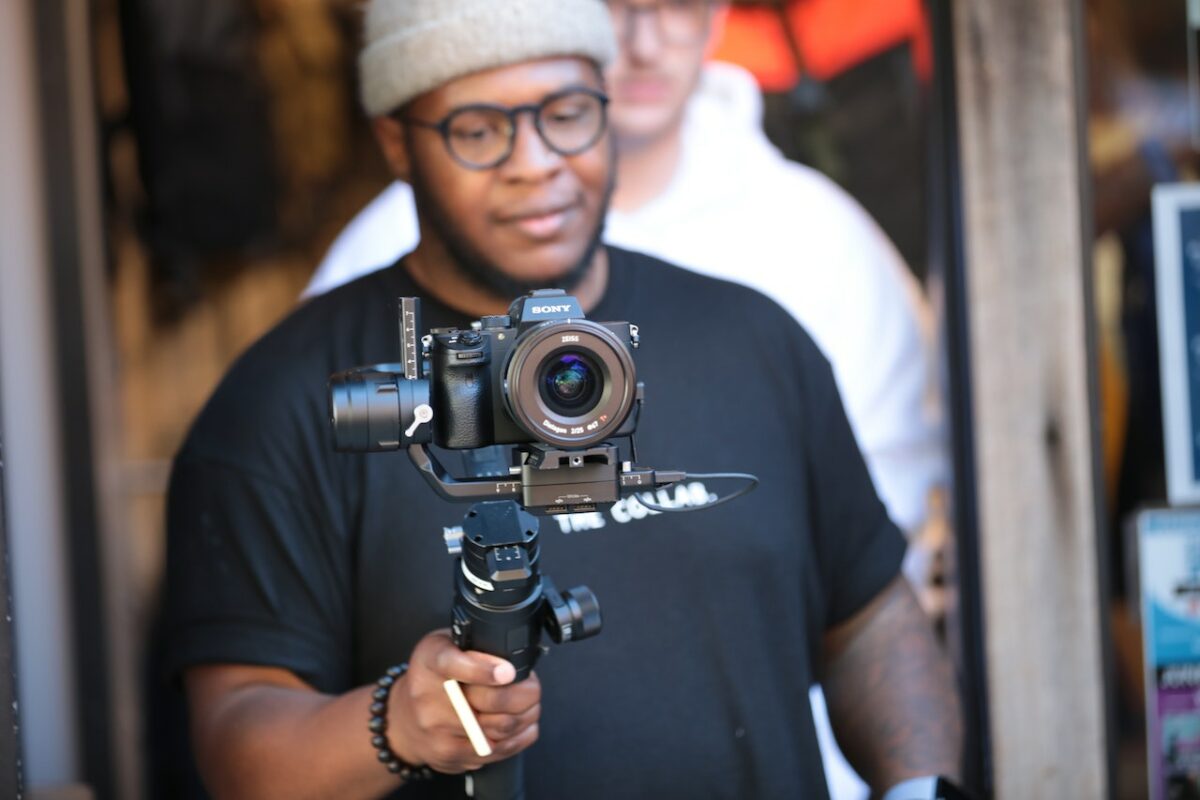
Generally, one of the main reasons real estate photographers prefer gimbals over traditional tripods is their flexibility and portability. Although almost all gimbals can be considered to be portable, they come in varying sizes and weights, making some more portable than others.
If you want to shoot with the gimbal handheld for an extended time, consider going for a compact and lightweight gimbal such as the Zhiyun Crane M2. However, lightweight gimbals tend to be less stable than their heavier counterparts. Typically, an easy-to-use gimbal balances the weight of the camera like a beam balance.
That means the stability of the Sony A7III depends on the counterweight. Since most lightweight gimbals have lower counterweights, they tend to tilt over when you tilt the camera to certain degrees. If you plan to shoot with a gimbal and camera setup on the ground, consider going for a heavier one.
Most modern gimbals come with electronic features that help to enhance camera stabilization performance. For instance, most gimbals come with motors that move the arms to track the subject. Advanced gimbals might use artificial intelligence functions to make the balancing calculation.
The gimbal might also feature functions such as video start and stop, which pairs with your Sony A7III camera. Usually, these electronics draw power from the gimbal batteries. Although most of these batteries are rechargeable, you don't want batteries that die in the midst of a photo shoot.
If you are planning to take photos for an extended time, consider going for a gimbal with a battery life of more than 12 hours, such as the Zhiyun Weebill S. You should, however, keep in mind that the actual battery life will depend on the overall shooting style.
Although the best gimbals for Sony A7III might look alike at a glance, they come with different advanced features that affect their overall compatibility. Before getting a gimbal, it's important to consider whether it will be compatible with your Sony A7III. Apart from mounting the camera, a compatible gimbal allows electronic pairing with the camera.
This pairing allows you to perform tasks such as shutter releases and video recording adjustments using the gimbal controls, eliminating the need to handhold the camera and press the respective buttons. Typically, this reduces the chances of interfering with the camera's stability. You should also check if the quick release system enables faster and more convenient camera mounting and dismounting.
In most cases, the manufacturer indicates a series of camera models the gimbal can pair with. For instance, the manufacturer might indicate that the gimbal is compatible with the Sony A series DSLR cameras. If you are a beginner, go for a gimbal that specifically indicates Sony A7III, such as the Moza Aircorss 2.
Payload generally refers to the manufacturer's specified weight the gimbal can hold with the three axes without preventing the motors from running smoothly to maintain balance. The recommended maximum payload means the gimbal can support the weight safely and reliably without affecting its service life or draining the batteries faster than expected.
Usually, exceeding this weight can cause damage to the gimbal or make it topple over. When choosing the gimbal, consider the weight of the Sony A7III and the weight of the lens you are going to use, and then go for a gimbal with an equivalent recommended payload.
For instance, the recommended maximum payload for the DJI RS 2 Combo is 10 pounds, and you can't expect a Sony A7III to exceed this weight even with a heavy zoom lens such as the Sony 24-70mm f/2.8.
Generally, there are two types of connections: wired and wireless. A wired connection means the devices are connected to one another through a physical cable. Wireless connection means the devices are connected through a wireless signal using a transmitter and a receiver.
With advancements in technology, most devices are using Bluetooth and WiFi wireless connectivity, and gimbals are no exception. Usually, this allows the gimbal to pair with other devices that use Bluetooth and WiFi connections, such as smartphones and advanced cameras, such as the Sony A7III. However, these features can consume battery life faster.
In most cases, gimbals that support Bluetooth and WiFi connections, such as the DJI Ronin SC, also come with a mobile app that you can use to pair them with a smartphone. This allows you to remotely control the gimbal, making it more versatile as you can place it on the ground and film yourself.
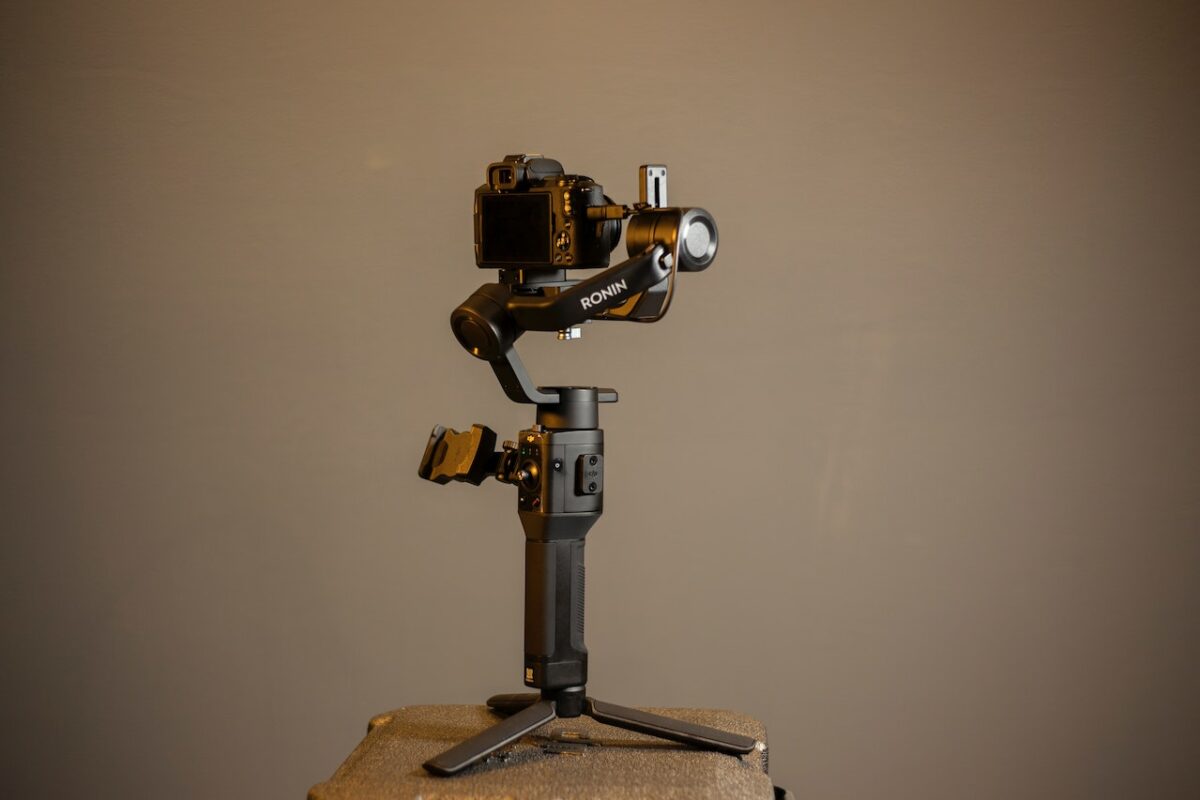
Although different gimbals might have the same physical design features, they might differ in the number of shooting modes and performance, affecting their overall versatility to capture smooth and stable footage. In most cases, each mode contains performance features that make the gimbal suitable for certain conditions.
For instance, the Go Mode in the Zhiyun Weebill S increases the speed of the gimbal to allow it to track a fast-moving subject. As a result, you can use this gimbal to capture timelapse shots of action and sports. On the other hand, a gimbal such as the DJI Ronin SC comes with a 360 degrees panning mode, which allows it to capture 3D motion shots.
That means if you want a versatile gimbal with a wide range of shooting modes and advanced features, go for one with the highest number of operation modes. Keep in mind that some modes might only be operable when using the mobile app.
The Sony A7III is a high-end camera that allows you to lock the focus. You simply need to press the center button, and it will detect the subject around the center of the frame and automatically track it, enhancing the overall sharpness and composition of the images.
However, even if the camera tracks the subject, it might not help if the subject moves out of the field of view and the gimbal can’t track it. Advanced gimbals such as the DJI RS 3 Pro have an active tracking function, an intelligent feature that helps the gimbal track the main subject even while using different shooting modes.
It’s not advisable to enable your Sony A7III image stabilization feature when using a gimbal. Typically, this is because the gimbal is a camera stabilizer, and you don’t need further stabilization. Enabling the feature might cause the system to hunt for camera shakes, introducing camera shakes itself.
The type of lens matters when using a Sony A7III with a gimbal due to weight variations. For instance, telephoto zoom lenses tend to be longer and heavier than wide-angle prime lenses. As a result, telephoto zoom lenses require gimbals with higher maximum payloads or gimbals that allow you to attach extra counterweights to help balance the camera.
If you don't balance the gimbal correctly, you might end up overworking the motors, which will drain the battery power faster than usual. The unbalanced position may also cause irregular movements of the image, which may result in unsteady footage, especially in some shooting modes.
With the best gimbal for Sony A7III, you can shoot steady real estate video tours or even 360 degrees interior motion shots. The best gimbals for Sony come with several modes of operation, making them versatile and suitable for a wide range of shooting conditions.
